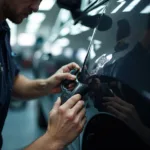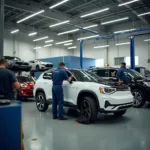Car window repair. It’s one of those things you never think about until you desperately need it. Whether it’s a tiny chip from a stray pebble on the highway or a more significant crack from a hailstorm, damaged auto glass is more than just unsightly—it’s a safety hazard.
But before you start calling around for quotes, there are a few things you should know about car window repair. Understanding the process, your options, and the costs can save you time, money, and a whole lot of headaches down the road.
Types of Car Window Damage
Not all car window damage is created equal. Knowing what kind of damage you have is the first step in determining the best course of action.
- Chips: Small, often circular breaks in the glass, usually caused by rocks or other debris.
- Cracks: Linear fractures in the glass, which can vary in length and severity. Cracks can be caused by impacts, extreme temperature changes, or even a poorly installed window.
- Stars: Star-shaped cracks that radiate outwards from a central impact point.
- Bullseyes: Circular cracks with a central impact point, resembling a bullseye target.
- Combination Breaks: Damage that incorporates multiple types of breaks, such as a chip with cracks extending from it.
The type and severity of the damage will determine whether a repair is possible or if a full window replacement is necessary.
Car Window Repair vs. Replacement: Which One Do You Need?
Generally, small chips and cracks that are less than a certain size (usually around the size of a dollar bill) can be repaired. Larger cracks, those that obstruct the driver’s view, or damage that affects the structural integrity of the glass will likely require a complete window replacement.
Repairing a car window involves injecting a special resin into the damaged area. This resin cures under UV light, filling the chip or crack and restoring the structural integrity of the glass. Repairing a window is often a quicker and more cost-effective solution than replacement.
Replacing a car window involves removing the damaged glass and installing a new one. This is a more involved process that requires specialized tools and expertise.
Factors Affecting Car Window Repair Costs
Several factors can influence the cost of your car window repair, including:
- Type and severity of damage: As mentioned, smaller chips are generally less expensive to repair than larger cracks or more complex damage.
- Location of the damage: Damage in the driver’s line of sight may require more intricate repair work, potentially increasing the cost.
- Type of glass: Windshields are often made with laminated glass, which is more expensive to replace than the tempered glass used in side and rear windows.
- Vehicle make and model: Luxury or rare vehicles may have more expensive glass, leading to higher repair or replacement costs.
- Your insurance coverage: Your auto insurance policy may cover some or all of the cost of car window repair or replacement.
DIY vs. Professional Car Window Repair
While DIY car window repair kits are available, it’s generally recommended to leave this task to the professionals. Properly repairing car windows requires specialized tools, knowledge, and experience. A poorly executed DIY repair can worsen the damage, making a professional repair more difficult (and expensive) down the line.
Finding a Reputable Car Window Repair Shop
When choosing a car window repair shop, consider these factors:
- Reputation and experience: Look for shops with positive customer reviews and a proven track record.
- Certifications and affiliations: Reputable shops often hold certifications from industry organizations, such as the Auto Glass Safety Council (AGSC).
- Warranty: A reputable shop will stand behind their work with a solid warranty.
- Convenience: Consider factors like location, hours of operation, and whether they offer mobile repair services.
Tips to Prevent Further Car Window Damage
- Maintain a safe following distance: This gives you more time to react to debris on the road.
- Avoid driving behind construction vehicles or trucks carrying loose materials: These vehicles are more likely to kick up rocks and other debris.
- Repair chips and cracks promptly: Small chips and cracks can quickly spread, so it’s best to address them sooner rather than later.
- Be mindful of temperature changes: Extreme heat or cold can weaken glass, so park in shaded areas whenever possible.
Car Window Repair: FAQs
Q: Can a cracked windshield shatter?
While rare, a severely weakened windshield could potentially shatter upon impact. However, laminated windshields are designed to hold together even when broken, preventing the glass from completely breaking apart.
Q: How long does a car window repair take?
Minor chip repairs can often be completed within 30 minutes to an hour. Larger cracks or more complex repairs may take longer.
Q: How long after a repair can I drive my car?
Most repair resins cure quickly, allowing you to drive your car shortly after the repair is complete. However, your technician will advise you on the specific curing time for the resin used.
Q: Does car window repair last?
A properly executed car window repair can last for the life of your vehicle.
Q: Will my insurance cover car window repair or replacement?
Coverage varies depending on your specific insurance policy. Contact your insurance provider to confirm your coverage.
Need Help with Your Car Window?
Don’t wait for a small chip to become a big problem. If you have any questions or need assistance with your car window repair, don’t hesitate to reach out. Contact our team of experts 24/7 via WhatsApp at +1(641)206-8880 or email us at [email protected]. We’re here to help you get back on the road safely.



